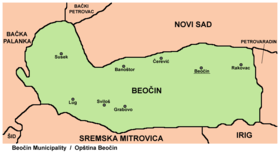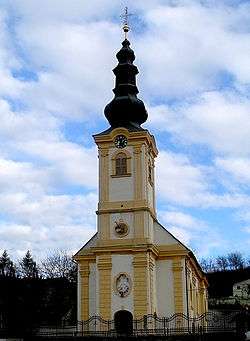Beočin
| Beočin Беочин | ||
|---|---|---|
| Municipality and Town | ||
|
Old Serbian Orthodox Church in Beočin | ||
| ||
 Location of the municipality of Beočin within Serbia | ||
| Coordinates: 45°12′N 19°44′E / 45.200°N 19.733°ECoordinates: 45°12′N 19°44′E / 45.200°N 19.733°E | ||
| Country | Serbia | |
| Province | Vojvodina | |
| District | South Bačka | |
| Settlements | 8 | |
| Government | ||
| • Mayor | Bogdan Cvejić | |
| Area[1] | ||
| • Municipality | 186 km2 (72 sq mi) | |
| Population (2011 census)[2] | ||
| • Town | 7,839 | |
| • Municipality | 15,726 | |
| Time zone | CET (UTC+1) | |
| • Summer (DST) | CEST (UTC+2) | |
| Postal code | 21300 | |
| Area code | +381 21 | |
| Car plates | NS | |
| Website |
www | |
Beočin (Serbian Cyrillic: Беочин, pronounced [bɛɔ̌tʃiːn]) is a town and municipality in the Vojvodina province, Serbia. The population of the town is 7,839, whilst Beočin's municipality population is 15,726. There is also a Beočin Monastery from the 16th century in the municipality.
Name
In Serbian, the town is known as Beočin (Беочин), in Croatian as Beočin, in Hungarian as Belcsény, in German as Beotschin, in Slovak as Beočín, and in Rusyn as Беочин.
The name of the town derived from the word that came from local Serbian dialect, which in modern standard Serbian would be written as "beli otac" or in English as "white father" (the full meaning of the name is "the place that belong to white father"). The name referred to the prior of the nearby Beočin monastery.
Geography
Although it is geographically located in Syrmia, Beočin administratively belong to South Bačka District. The town of Beočin is divided into two parts: Beočin Grad ("Beočin town") and Beočin Selo ("Beočin village"). However, no matter that Beočin Selo is called a village, it is not a village but simply part of the town.
History
Existence of the Serbian Orthodox monastery of Beočin (which is located 2 km in the south from modern town) was first recorded by the sources in 1566-67.[3] Until the end of the 18th century, a small settlement (hamlet) existed near this monastery. During Ottoman administration, this settlement was populated by ethnic Serbs.[4]
Settlement from which modern Beočin developed was mentioned first in 1702. In the beginning it was only a village, and its basic economic activity was vine production (even today, the oldest part of Beočin is known as Beočin Selo, i.e. "Beočin village" in English). After the cement factory was opened (in 1871), Beočin developed into a modern town, which over time became the centre of the northern Syrmia. The cement factory in Beočin is one of the largest cement factories in Europe. New, urban part of the town, started to develop as worker's colony and it was known as Fabrika ("factory"), Beočin Fabrika ("Beočin factory") and Beočin Grad ("Beočin town").
Until the middle of the 18th century, the village of Beočin was under Habsburg military administration. After 1745, it was part of the Syrmia County, which was one of three counties of the Habsburg Kingdom of Slavonia. In 1828, majority of inhabitants of Beočin village were Orthodox Christians.[5]
In 1848–49, Beočin was part of Serbian Vojvodina, while from 1849 to 1860 it was part of the Voivodeship of Serbia and Banat of Temeschwar. After the abolishment of the voivodeship in 1860, Beočin was again incorporated into Syrmia County of the Kingdom of Slavonia. In 1868, Kingdom of Slavonia was joined with the Kingdom of Croatia into the Kingdom of Croatia-Slavonia, which was part of the Kingdom of Hungary and Austria-Hungary. In 1910, population of Beočin Selo numbered 3,342 inhabitants, while population of Beočin Fabrika numbered 262 inhabitants. According to 1910 census, largest ethnic group in Beočin were Serbs, while other ethnic groups that lived in the settlement included Hungarians, Germans, Croats, and others.[6]
In 1918, Beočin first became part of the State of Slovenes, Croats and Serbs, then part of the Kingdom of Serbia and finally part of the Kingdom of Serbs, Croats and Slovenes (later renamed to Yugoslavia). From 1918 to 1922, Beočin was part of the Syrmia county, from 1922 to 1929 part of the Syrmia oblast, from 1929 to 1939 part of the Danube Banovina, and from 1939 to 1941 part of the Banovina of Croatia. During World War II, from 1941 to 1944, Beočin was occupied by Axis troops and was included into the Pavelić's Independent State of Croatia. During the Axis occupation, 66 civilians were killed in Beočin by fascists. In 1944, Beočin was liberated by Yugoslav partisans. Since 1944, the town is part of Vojvodina, which (from 1945) was an autonomous province of Serbia and Yugoslavia.
Until the end of World War II, Beočin was part of Ilok municipality. Since the newly established post-WW2 border between Vojvodina (Serbia) and Croatia divided former Ilok municipality, Beočin was included into Novi Sad municipality. Later, separate municipality of Beočin was established. In 1948, population of Beočin Fabrika numbered 2,144 inhabitants, while population of Beočin Selo numbered 1,495.
Historical population of the town
Population of Beočin in various years, including both historical parts of modern town (Beočin Grad and Beočin Selo):
- 1921: 2,946
- 1931: 3,857
- 1948: 3,639
- 1953: 4,082
- 1961: 5,145
- 1971: 6,563
- 1981: 7,298
- 1991: 7,873
- 2002: 8,058
- 2011: 7,839
Inhabited places

Beočin municipality encompasses the town of Beočin, and the following villages:
| No. | Name | Status | Urban municipality | Population(2011 data) |
|---|---|---|---|---|
| 1 | Banoštor | village | Beočin | 737 |
| 2 | Grabovo | village | Beočin | 100 |
| 3 | Lug | village | Beočin | 709 |
| 4 | Rakovac | village | Beočin | 2,248 |
| 5 | Sviloš | village | Beočin | 291 |
| 6 | Susek | village | Beočin | 998 |
| 7 | Čerević | village | Beočin | 2,798 |
Ethnic groups (2002 census)
The population of the Beočin municipality:
Most of the settlements in the municipality have an ethnic Serb majority, while the village of Lug have an ethnic Slovak majority.
Religion (2002 census)
In 2002, population of the Beočin municipality included following religious groups:
- Orthodox Christians = 11,412
- Catholics = 1,513
- Muslims = 963
- Protestants = 887
Beočin is one of the centers of the Islamic Community of Vojvodina. As of 2006, it was one of the three settlements in Vojvodina where Islamic religious buildings could be found (The other two settlements are Novi Sad and Subotica).
Culture
The oldest Serb rural schools in Vojvodina were established in the territory of present-day Beočin municipality: in Grabovo (1625) and Sviloš (1695). There are also two important Serbian Orthodox monasteries in the territory of this municipality: Beočin monastery, whose existence was first recorded in 1566-67 and Rakovac monastery, whose existence was first recorded in 1545-48.
Politics
Seats in the municipal parliament won in the 2004 local elections:
- Serbian Radical Party (11)
- Democratic Party (5)
- Socialist Party of Serbia (4)
- Democratic Party of Serbia (3)
- Strength of Serbia Movement (3)
- G17 Plus (3)
- Socialdemocratic party of Roma in Serbia (2)
- New Serbia (2)
Twin Cities
See also
References
- Miloš Lukić, Putevima slobode - naselja opštine Beočin u ratu i revoluciji, Novi Sad, 1987.
- Slobodan Ćurčić, Broj stanovnika Vojvodine, Novi Sad, 1996.
- Slobodan Ćurčić, Naselja Srema - geografske karakteristike, Novi Sad, 2000.
- Sekula Petrović, Beo-činovi, pozorišni život u Beočinu 1908-2009, Ruma, 2009.
Notes
- ↑ "Municipalities of Serbia, 2006". Statistical Office of Serbia. Retrieved 2010-11-28.
- ↑ "2011 Census of Population, Households and Dwellings in the Republic of Serbia: Comparative Overview of the Number of Population in 1948, 1953, 1961, 1971, 1981, 1991, 2002 and 2011, Data by settlements" (PDF). Statistical Office of Republic Of Serbia, Belgrade. 2014. ISBN 978-86-6161-109-4. Retrieved 2014-06-27.
- ↑ Gvozden Perković, Verski objekti na tlu Vojvodine, Novi Sad, 2006, page 36.
- ↑ Dr Dušan J. Popović, Srbi u Vojvodini, knjiga 1, Novi Sad, 1990, page 110.
- ↑ http://img409.imageshack.us/img409/5176/szeremmx9.png[]
- ↑ "Archived copy". Archived from the original on 2011-10-07. Retrieved 2011-06-28.
External links
| Wikimedia Commons has media related to Beočin. |




